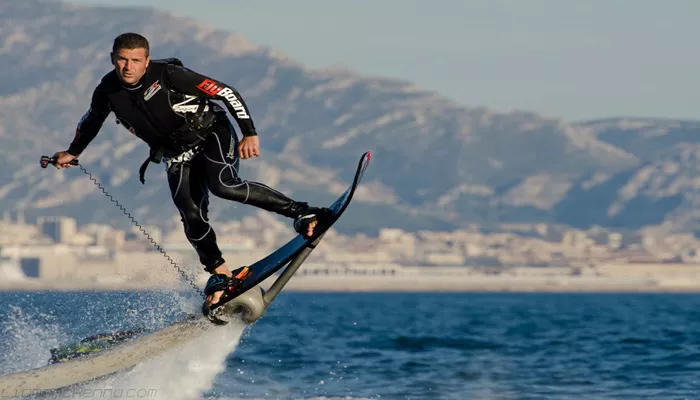Hover surfing is a new and exciting extreme sport. It combines the feel of surfing with the power of flight. Riders stand on a board that hovers above the ground or water. The board is powered by propellers and engines. These give it lift and thrust. It looks like something from science fiction. But it is real. And it is becoming more popular.
Hover surfing uses electric or fuel-powered hoverboards. These are not like the small two-wheeled hoverboards that became popular in the mid-2010s. Hover surfboards are much more advanced. They can fly over land or water at high speeds. Some models can reach speeds of up to 60 miles per hour. They can also climb several meters into the air.
This sport is still very new. Most hoverboards are prototypes or limited-release products. But it has already captured the imagination of thrill-seekers, tech lovers, and extreme sports fans around the world.
How Hover Surfing Works
Hover surfing uses a special kind of board. It is designed with propellers or ducted fans. These fans push air downward. This gives the board lift. The rider controls the direction and height with a handheld remote or through balance.
Basic Parts of a Hover Surfboard
Propulsion System: Usually consists of four to six rotors. These create vertical lift.
Battery or Engine: Most use lithium-ion batteries. Some may use gas turbines for longer flight.
Flight Controller: Keeps the board stable. Works like a drone autopilot.
Frame and Deck: This is where the rider stands. It is built from lightweight but strong materials like carbon fiber.
Safety Features: Includes emergency shut-off, GPS, and some even have parachutes.
The rider wears protective gear like a helmet, gloves, and a flight suit. Some also wear knee pads and back protectors.
Hover surfing is controlled much like a drone. You lean in the direction you want to go. The remote controller can help you rise, descend, or stop. Stability is maintained by computer systems onboard.
The History And Evolution of Hover Surfing
Hover surfing has roots in drone technology. Early versions were developed by tech startups and drone engineers. The idea was simple: scale up a drone large enough to carry a person.
One of the first companies to make this happen was Hoversurf, based in Russia. In 2017, they introduced the Scorpion-3, a hoverbike that looked like a flying motorcycle. It gained attention around the world.
Since then, many companies and inventors have entered the scene. Some are building boards for fun. Others are working on hover vehicles for search and rescue, police, or even military use.
Here are a few key milestones:
2015–2017: First successful manned flight on a hoverboard by Hoversurf.
2018: French inventor Franky Zapata flew across the English Channel on a jet-powered hoverboard.
2020–present: Continued development of electric hoverboards for sport and transport.
As batteries get lighter and more powerful, hoverboards become more efficient. This helps the sport grow.
Types of Hover Surfboards
Hover surfboards come in different designs. Some are made for water. Others are for land or open air.
1. Jet-Powered Hoverboards
These use jet engines. They can fly very fast and high. They are hard to control and usually used by professionals.
2. Electric Propeller Hoverboards
These are more common in hover surfing. They use four or more propellers. They are safer and quieter.
3. Water-Based Hoverboards
These are often powered by a hose connected to a jet ski. Water is pushed down to lift the board. These are popular for recreation and shows.
4. DIY Hoverboards
Some hobbyists build their own. These vary in safety and power. They are not recommended for beginners.
Benefits of Hover Surfing
Hover surfing is thrilling. But it also has other benefits.
1. Adrenaline and Fun
The feeling of flying is like no other. Riders often say it is the most exciting sport they’ve tried.
2. Improved Balance and Focus
Controlling a hoverboard takes concentration. It improves your reaction time and mental focus.
3. Physical Fitness
Balancing, standing, and managing the hoverboard builds core strength and stamina.
4. Innovation and Tech Learning
Hover surfing puts you at the front of modern technology. You learn about flight systems, batteries, and aerodynamics.
How to Get Started with Hover Surfing
Hover surfing is not a beginner sport. It requires training, safety awareness, and sometimes even a license.
Step 1: Understand the Equipment
Start by learning how the hoverboard works. Watch videos. Read manuals. Talk to experts.
Step 2: Train on Simulators
Before flying, many beginners use flight simulators. These help you learn controls in a safe way.
Step 3: Practice With Instructors
Find a hover surf training center. Work with experienced pilots. Start with low, short flights.
Step 4: Wear Proper Safety Gear
Never ride without a helmet. Always wear protective clothing. Flying at even a few feet off the ground can be dangerous.
Step 5: Learn Flight Rules
In many countries, flying devices must follow airspace rules. You may need to register your hoverboard as a drone or aircraft.
Risks And Challenges
Like all extreme sports, hover surfing has risks. Here are a few:
1. Injury from Crashes
Falls and crashes can lead to broken bones, concussions, or worse. Always train before flying high.
2. Device Failure
If the battery or motor fails, the board can drop suddenly. Some boards now include parachutes for emergencies.
3. Airspace Laws
In many areas, flying devices must follow drone laws. Hoverboards may be restricted near airports, cities, or national parks.
4. Weather Conditions
Strong winds, rain, or heat can affect flight safety. Always check the weather before riding.
Conclusion
Hover surfing is more than just a sport. It is a step into the future. It combines adventure, technology, and flight. While still young, it is already capturing hearts and headlines. If you dream of flying, hover surfing might be for you. But always train safely. Know your limits. And enjoy the ride.

